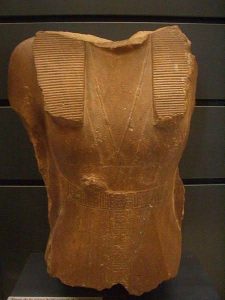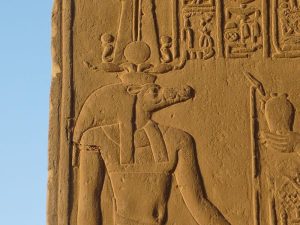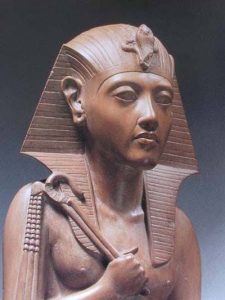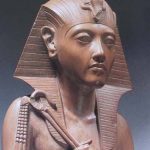When we think of the word pharaoh, many of us conjure up mental images of Tutankhamun Ramsses or in some cases, Cleopatra However, when researching the history of the rulers of Egypt, women are largely excluded, and a pharaoh is almost always pictured as a male.
Sobekneferu was the first female Pharaoh to rule Egypt in her own right, but despite this, her story is missing from many history textbooks. It is therefore necessary to uncover the history of these female pharaohs as they played a vital part not only in the political history of Egypt but also in the history of the world.
The structure of Egyptian royalty was undoubtedly meant for men. The Pharaoh was seen as the earthly manifestation of the male god Horus, and it was normal and expected that the king would be succeeded by his eldest son. However, fate would have it that every so often, this system failed, and a woman found herself on the throne of Ancient Egypt.
Sebeknefru, queen who ruled as king of ancient Egypt (c. 1760–c. 1756 BCE); she was the last ruler of the 12th dynasty (1938–c. 1756 BCE).
When she was made pharaoh, Sobekneferu went through the customary naming ceremony and was given five names as used by pharaohs.

Some claim there were a handful of female pharaohs prior to Sobekneferu. One of the earliest was Merytneith (1st dynasty). It is thought that she was the wife of Djet and acted as regent for her son, Den, in his early years. While this gave her some ruling authority, it did not actually make her ruler in her own right, as Sobekneferu was.
Another rival to the claim of being the first female pharaoh is Khentkaues I (4th dynasty). On the doorway of her tomb in Giza. there is written a title which can be translated to either “Mother of Two Kings” or “King and Mother of a King.” There are also images of her that show her in king-like poses and even wearing a false beard!
Like Merytneith, it is possible that she ruled when her son, Sahure, was too young to rule himself, possibly alongside Userkaf (founder of the 5th Dynasty). She was also commemorated in the pyramid of Khentkaues II, but her name cannot be located in a royal cartouche. Furthermore, most modern lists of Egyptian rulers do not include Khentkaues either.
Sobekneferu linked herself to her father, Amenemhet III, in many of her monuments. One example is the depiction of a serekh (essentially a royal crest) which shows Amenemhat III holding the ankh (the hieroglyph meaning life) to Sobekneferu. This seems to depict the legitimacy of Sobekneferu’s claim to the throne.

Three statues without heads have been discovered in Fayoum and are thought to be Sobekneferu. One depicts her, much like the crown mentioned above, in elements of both male and female dress.
While many of the images show her wearing male clothing, there is no evidence that she was trying to pretend to be a man. Most of the time, she used female suffices in her titles. Despite this, some scholars have argued that in wearing male clothing, she was attempting to pacify those who criticized her rule as a woman. Meanwhile, others have gone as far as to argue that she saw her own gender as an embarrassment and was attempting to hide it.
Her statues also show Sobekneferu in full royal regalia as a male king would have worn, posing in royal positions. In one image, she is even shown wearing a sheath dress and a male kilt, and in another, wearing a sed festival cloak. There is also an image that shows her wearing what has been considered by many as an unusual crown. Some have argued that this strange headpiece may have resulted from an attempt to combine the crowns of both a king and a queen. The statue is held today in the Metropolitan Museum in New York.

Sobekneferu or Neferusobek Sbk-nfrw in ancient Egyptian language which means ‘Beauty of Sobek’)
Sobek was an ancient Egyptian deity (also called Sebek or Sobki) with a complex and elastic history and nature.
He is associated with the Nile crocodile represented in its form or as a human with a crocodile head.

Sobeknefru was the first well-known female Pharaoh and the last ruler of the Twelfth Dynasty of the Middle Kingdom.She ascended to the throne following the death of Amenemhat 4th her brother, she asserted legitimacy through her father Amenemhat 3rd, Her reign lasted 3 years, 10 months, and 24 days, according to theTurin king list.
The end of the long reign of Sebeknefru’s father, Amenemhat 3rd brought her half brother to the throne late in life. When her brother died, the absence of a male heir made Sebeknefru the closest in line of succession; she thus took the royal titles and ruled as king.
Sebeknefru reigned as a full pharaoh: her statues show her with full royal (king’s) regalia and in traditional royal poses. Nonetheless, she made no attempt to depict herself as a man, as did Queen Hatshepsut of the 18th dynasty.

The title of pharaoh is synonymous with the grandeur of the ancient Egyptian civilization. This name—which means “great house” in hieroglyphics—was given to the rulers who led this large empire. And while the majority of these figures were men like king Tut, Ramesses II, Thutmosis there were a few influential women who earned the title. The first recorded female pharaoh was Sobekneferu.
After the death of Amenemhat IV, who may or may not have been her brother and husband, Sobekneferu assumed the throne. Although her reign only lasted about four years, she was the first known female ruler to adopt the full royal titulary and to be recorded in the Turin King List—a recording of ancient Egyptian kings written on papyrus. Her end as ruler marks the end of the Twelfth Dynasty of the Middle Kingdom of Egypt.
Sobekneferu was one of the few women that ruled in Egypt, and the first to adopt the full royal titulary, distinguishing herself from any prior female rulers. She was also the first ruler associated with the crocodile god Sobek by name, whose identity appears in both her birth and throne names.
Sobekneferu’s Death
Unfortunately, Sobekneferu’s burial place is unknown. Some have suggested that it may be in a damaged pyramid complex located near Amemenhat IV at Mazghuna. however, has argued that there is no evidence of this claim.
Sobekneferu is remembered today as the last Egyptian king of the Middle Kingdom. She was also the last ruler before the New Kingdom to appear in the lists found at Abydos and Saqqara. Despite ruling for less than four years, she was the first female pharaoh to rule with full royal titulary and to be recorded in the Turin King list.
she had no children of her own and did not continue her line, leading to the end of the Twelfth dynasty.


